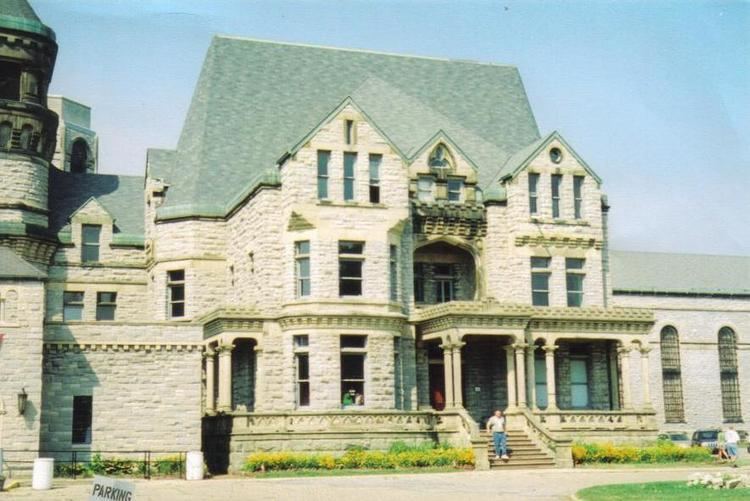Area 40 acres (16 ha) NRHP Reference # 83002039 Opened 1886 | Built 1886 Added to NRHP April 14, 1983 Phone +1 419-522-2644 Architect Levi Scofield | |
 | ||
Address 100 Reformatory Rd, Mansfield, OH 44905, USA Profiles | ||
Ohio state reformatory mansfield
The Ohio State Reformatory (OSR), also known as the Mansfield Reformatory, is a historic prison located in Mansfield, Ohio in the United States. It was built between 1886 and 1910 and remained in operation until a 1990, when United States Federal court ruling (the 'Boyd Consent Decree') ordered the facility to be closed. While this facility was used in a number of films (including several while the facility was still in operation), TV shows and music videos, it was made famous by the film The Shawshank Redemption (1994) when it was used for the majority of the movie.
Contents
- Ohio state reformatory mansfield
- Paranormal investigation of the ohio state reformatory
- History
- Restoration and tours
- Films and television
- References
Paranormal investigation of the ohio state reformatory
History
The history of the Ohio State Reformatory began in 1861, the field where the reformatory would be built was used as a training camp for Civil War soldiers. The camp's name had significant meaning to Ohio as it was named Camp Mordecai Bartley in honor of the Mansfield man who served as Ohio governor in the 1840s.
In 1867, Mansfield was promoted as a candidate for the placement of the new Intermediate Penitentiary (the original name before it was changed to Ohio State Reformatory). The city raised $10,000 to purchase 30 acres of land for the prison, and the state acquired 150 acres of adjoining land for $20,000; the cost of the facility was $1,326,769. The Intermediate (Ohio State Reformatory) was intended as just that, a halfway point between the Boys Industrial School in Lancaster and the State Penitentiary in Columbus which was intended to house young first-time offenders. Construction began in 1886 and remained under construction until 1910 due to funding problems which caused construction delays. The original architect for the design was Levi T. Scofield from Cleveland, who used three architectural styles; Victorian Gothic, Richardsonian Romanesque and Queen Anne. Scofield designed the reformatory with these unique styles to help encourage inmates to become reborn back into their spiritual lives. The creation and construction of the entire building was entrusted to well-known architect F.F. Schnitzer, whose name also appears on the cornerstone, and is recorded as Superintendent in documents found there. In 1891 the name was changed from Intermediate Penitentiary to Ohio State Reformatory.
On September 15, 1896 the reformatory opened its doors to its first 150 offenders. These prisoners were brought by train from Columbus and put immediately to work on the prison sewer system and the 25-foot stone wall surrounding the complex. Schnitzer was presented with a silver double inkwell by the governor of the state in a lavish ceremony to thank him for his services. The exterior of the building, which is built from brick and concrete, is designed in the Romanesque style giving the frontage a castle-like appearance.
The Reformatory remained in full operation until December 1990 when it was closed via federal court order. As the result of a prisoners' class action suit citing overcrowding and inhumane conditions (Boyd v. Denton, C.A. 78-1054A (N.D.Oh.)), District Judge Frank J. Battisti of the United States District Court for the Northern District of Ohio ordered the prison closed by the end of December 1986. This order was known as the Boyd Consent Decree. The closing date was moved to 1990 due to delays in constructing the replacement facility, which stands to the west of the old prison, the Mansfield Correctional Institution.
Most of the grounds and support buildings, including the outer wall, have been demolished since the closing. In 1995, the Mansfield Reformatory Preservation Society was formed. They have turned the prison into a museum and conduct tours to help fund grounds rehabilitation projects and currently work to stabilize the buildings against further deterioration.
The East Cell Block remains the largest free standing steel cell block in the world at six tiers high. From 1935 until 1959 Arthur Lewis Glattke was the Superintendent. Initially a political appointment following Glattke's work on the Martin Davey campaign, by all accounts Glattke was respected by professionals and inmates alike. He implemented many reforms such as piped in radio music in the cell blocks. Glattke's wife, Helen Bauer Glattke, died of pneumonia three days following an accident in November 1950 where a handgun discharged when she was reaching into a jewelry box in the family's quarters. Glattke died following a heart attack suffered in his office on February 10, 1959. Over 200 people died at the OSR, including two guards who were killed during escape attempts.
Restoration and tours
The Mansfield Reformatory Preservation Society is currently working to restore the facility to its original state. Restorations to date include the removal of debris, replacement of roofing, complete restoration of the Warden's quarters, as well as the complete restoration of the central guard room between the East and West Cell Blocks. The restorations are being funded through donations and tour fees. The windows of the south side east cell block have been replaced, as well as all of the original stained glass windows that were in the building and are currently being re-installed in the building.
Films and television
The facility has been used in many productions (even while it still held inmates), and perhaps became best-known when it was portrayed as Shawshank State Prison in the 1994 film The Shawshank Redemption.
